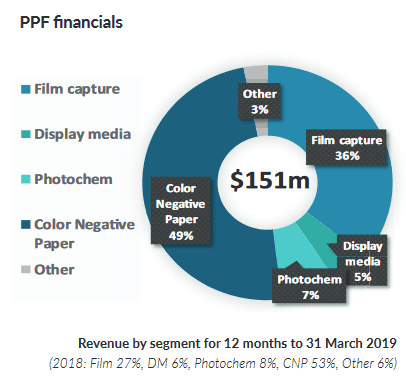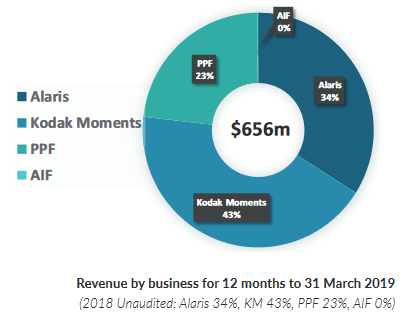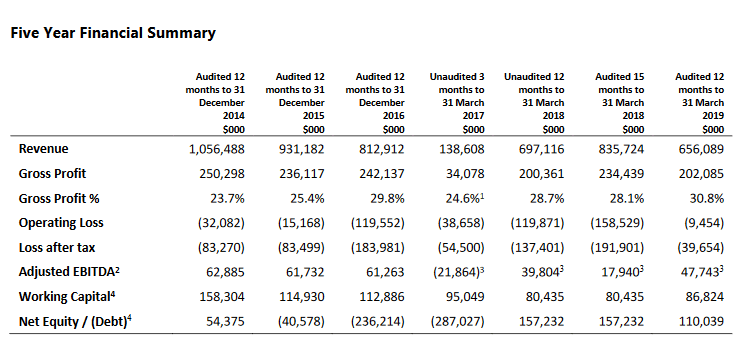Kodak Alaris has revealed in its 2019 Annual Report that its Paper, Photochemicals and Film (PPF) business, and possibly other business units, remain up for sale, after the ‘preferred bidder’ withdrew its offer ‘at the date of signing the financial statements’.
 Eastman Kodak off-loaded Kodak Alaris, along with a multi-billion dollar debt, to the UK Kodak Pensions Plan (KPP2) in 2014. Since then the business has contributed very little – if anything at all – to the UK pensioners it was supposed to support.
Eastman Kodak off-loaded Kodak Alaris, along with a multi-billion dollar debt, to the UK Kodak Pensions Plan (KPP2) in 2014. Since then the business has contributed very little – if anything at all – to the UK pensioners it was supposed to support.
Kodak Alaris consists of three key business units – PPF, Kodak Moments and an eponymous document imaging/management business unit. PPF represents just under one quarter of sales, with the Kodak Moments business representing another 43 percent.
Inside Imaging originally broke this story back in January, with Kodak Alaris CEO Marc Jourlait stating that key customers around the world had been privately briefed on the plans to ‘explore sales of some or all of our assets’ and that ‘PPF in particular we disclosed as at an advanced stage of negotiations with a potential buyers’.
 The initial aim was to have the sale of PPF completed before March 31 this year. This has now been put back to some time this financial year. (Kodak Alaris’ financial year runs from April 1 to March 31.) While PPF is classed in the annual report as a ‘discontinued operation’, it appears the rest of the business is also up for sale, with CEO Marc Jourlait referring in the report to ‘clear instructions received from our shareholder KPP2 to actively explore the sale and monetization of some or all of the company’s businesses and assets.’
The initial aim was to have the sale of PPF completed before March 31 this year. This has now been put back to some time this financial year. (Kodak Alaris’ financial year runs from April 1 to March 31.) While PPF is classed in the annual report as a ‘discontinued operation’, it appears the rest of the business is also up for sale, with CEO Marc Jourlait referring in the report to ‘clear instructions received from our shareholder KPP2 to actively explore the sale and monetization of some or all of the company’s businesses and assets.’
The latest Kodak Alaris financial report provides an update of the PPF sale: In January 2018, the [Kodak Alaris] Board of Directors approved a proposal to pursue the sale of its Paper, Photochemicals and Film (PPF) business and authorised management to initiate discussions with potential buyers. Management is actively marketing the business and had expected to complete a sale of the PPF business before 31 March 2019.
The associated assets and related liabilities were classified as held for sale, with the PPF business reported as a discontinued operation at 31 March 2018. As at the date of signing the financial statements, the preferred bidder withdrew their approach – however management remains committed to the plan to sell and, in line with the instruction received from the shareholder, a sale is expected to conclude during the financial year to 31 March 2020.
Management consider the withdrawal of the preferred bidder to be a non-adjusting post balance sheet event and the assets continue to be classified as held for sale with the PPF business reported as a discontinued operation. The non-recurring fair value measurement for the disposal group of $34,900, 000 (2018: $34,044,000) before $2.7 million in selling costs (2018: $2.800 million)…’
The sale of chunks of Kodak Alaris is one of Kodak Alaris management’s ‘two prime objectives’ (the other being ‘turnaround and transformation’: ‘ (ii) ‘Progressing the potential sale of our business, or elements of the group, in line with instructions received from KPP2 in 2018.’
Elsewhere the annual report states: ‘The successful completion of the sale of the PPF business in the next year, and the progress of a potential broader sales process, will remain a critical focus for the Board and management team.’
The pension obligation to the former Kodak UK employees is now being picked up by the UK Government’s own safety-net Pension Protection Fund, which it appears will ultimately own Kodak Alaris in the case it isn’t sold in its entirety:
‘The Pension Protection Fund has confirmed its desire to maximise the value of the Group, for both KPP2 and itself in the future. To this extent the Pension Protection Fund has confirmed that it will retain ownership of the Group, or parts of it, if appropriate fair valuations are not achieved through the sales process.’
 So the film and paper business is not the only part of Kodak Alaris up for sale, but simply ‘first cab off the rank’. The annual report notes that $5m was spent this year on ‘additional costs relating to transactions associated with the strategic review of disposal options’:
So the film and paper business is not the only part of Kodak Alaris up for sale, but simply ‘first cab off the rank’. The annual report notes that $5m was spent this year on ‘additional costs relating to transactions associated with the strategic review of disposal options’:
… As previously reported, KPP2 issued an instruction to the directors of the Company in September 2018 to undertake the active exploration of an orderly disposal of the Group or its component businesses, within the Kodak Alaris portfolio…
Given the instruction received, the directors and management team have actively progressed the planning and options to monetise the business and return funds to the shareholder over the coming years, recognising that this process is likely to take some considerable time.
…However, the exact nature, requirements and timing of this process will of course be determined by the nature of potential buyers and which assets are ultimately disposed.
In the medium-term, after settling all its obligations in a full divestiture scenario, the Company will liquidate any remaining legal entities of the Group.

When covering this story earlier this year Kodak Alaris CEO Marc Jourlait complained that Inside Imaging placed too much emphasis on the bottom line in its report, and not enough on EBITA (earnings before interest, taxes, amortization and non-recurring items), which he said was a better reflection of a company’s performance and showed Kodak Alaris to be in good financial health.
But the Kodak Alaris financials are, to the casual observer, and especially anyone running a small business, extraordinary. With sales of $656 million in 20129, Kodak Alaris enjoyed a handsome gross profit – after selling costs – of $202 million, or over 30 percent. EBITA was $48 million. Yet Kodak Alaris made an operating loss for the year and a loss after tax of $40 million – which it presented as an indication of good management, as the loss for the previous year was $191 million!
It’s worth noting that Kodak Alaris ‘has progressively moved to a fully outsourced manufacturing model, except for our paper finishing operations in Manaus, Brazil.’ That is, it’s a distributor for the photographic film, paper and photochemical products most readers of Inside Imaging would be interested in.
Beyond the confirmation that a sale of the film and paper business is imminent, the Annual Report also notes that there was 29 percent volume growth in the film business, ‘driven by the continued resurgence of interest in film photography.’
Kodak Moments’ global share of dry technology photo output is 22 percent, down from 24 percent in 2018. (‘The change results from the loss of a key APAC customer.’)
2019 Kodak Alaris Annual Report





Another one bails out